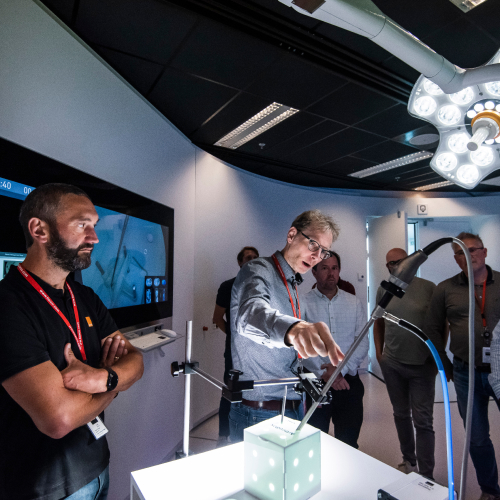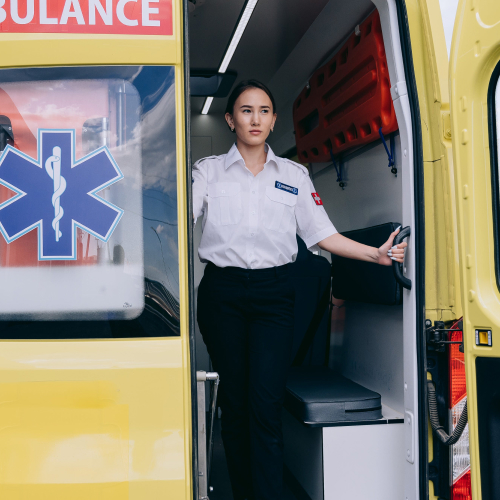5G for Business
Enhancing healthcare delivery
With its reliability and high bandwidth, 5G enables emerging technologies like IoT-enabled medical devices and advanced robotic surgeries, opening new frontiers in healthcare.
Healthcare industry challenges
Navigating the healthcare industry landscape
Due to the complex and sensitive nature of their operations, health companies face a unique set of challenges:
Rapid technological advancements
Healthcare is constantly evolving with the integration of new technologies, such as telemedicine, wearable devices, and artificial intelligence. Companies need to stay up-to-date with these advancements to remain competitive and provide the best patient care.
Data security and privacy
Healthcare organizations deal with sensitive patient data, making them prime targets for cyberattacks. Protecting patient information and maintaining data security is of paramount importance to prevent breaches and maintain trust with patients.
Changing patient expectations
Patients are becoming more informed and involved in their healthcare decisions. Healthcare companies must adapt to meet the rising expectations of patients for convenience, access to information, and personalized care.
Interoperability and data integration
Many healthcare systems and technologies lack seamless interoperability, leading to challenges in sharing patient data across different platforms and providers. Achieving data integration and interoperability is crucial for efficient healthcare delivery.
Talent shortages
The healthcare industry is experiencing shortages of skilled professionals in various fields, including nursing, physicians, and specialized medical technicians. Recruiting and retaining qualified staff can be challenging.
Explore other health examples
Deep dive into proven health 5G cases

The partner
Name: Barco, KU Leuven
Sector: Health
The challenge
Surgical procedures are becoming increasingly specialized and are making use of more complex medical devices such as surgical robots. Next to this there is a growing shortage of surgeons and surgeons are more often specializing in one or a few procedures. One possible solution is for the operating room team to work remotely with external experts.
The solution
Barco Nexxis live is for example a software solution making it possible for external experts to communicate in real time with the operating room team. This 5G project has two main objectives: the creation and (clinical) validation of a new generation solution for remote collaboration with teams in the operating room and the experimental research to see if it is possible (eventually) to also control surgical robot remotely (over 5G). This would allow for an external expert to remotely operate the surgical robot in a controlled manner for a (limited, but critical) portion of the operation. This 5G project uses Orange Belgium's network and has been selected by the Federal Government of Economy for subsidies to accelerate the rollout and the implementation of 5G use cases in Belgium.
Why is 5G essential?
This project encompasses two significant surgical applications enabled by 5G technology. First, it involves facilitating remote collaboration with surgical teams within the operating room through the use of mobile devices such as smartphones and tablets over 5G networks. Second, it delves into experimental research aimed at determining the feasibility of long-term remote control of surgical robots using 5G technology.

The partner
Name: EBO, POM, Jan Yperman Ziekenhuis, Howest, KU Leuven
Sector: Health
Project description
Normally, network operators begin the deployment of new technologies in densely populated cities or regions. Rural areas are either underserved or not served at all, which makes it challenging for them to foster local economic development. As a consequence, implementing innovative applications in these areas becomes difficult due to the lack of complete coverage. By rolling out a high-quality 5G network, the Westhoek will become a real smart region.
In this partnership, 5G is used for more efficient and high-quality assistance, public safety and care provision. The 5G project consists of four parts in order to improve operational efficiency and patient care:
- Medical drone transport
- Digital inclusion through high quality immersive experience
- Remote assistance through smart & connected first response vehicles
- Mobile communication center for disaster relief and event safety
Why is 5G essential?
This 5G project uses Orange Belgium's network and has been selected by the Federal Government of Economy for subsidies to accelerate the rollout and the implementation of 5G use cases in Belgium.

The partner
Name: e-BO Enterprises, Provinciale Ontwikkelingsmaatschappij West-Vlaanderen, Jan Yperman Ziekenhuis, Hogeschool West-Vlaanderen, KU Leuven
Sector: Health and Transportation & Logistics
Project description
Time is of utmost importance in medical care. Getting blood samples, medical equipment, medicine in time where it needs to be, saves lives. A drone network in the Westhoek region facilitating (urgent) medical transports between various healthcare organizations, their clients, and suppliers can help with these emergencies. To ensure maximum safety and reliability, the capabilities of the 5G network are used to intervene during the drone's operations and take manual control of the drone, for instance, when GPS/GNSS signals are lost or when a pilot needs visual contact with the surroundings during a specific flight. Transport over the air solves congestion and could be done automatically without using human resources. This 5G project uses Orange Belgium's network and has been selected by the Federal Government of Economy for subsidies to accelerate the rollout and the implementation of 5G use cases in Belgium.
Why is 5G essential?
Drones safer and more efficiently can be used for medical transport of, among other things, blood samples and Automatic External Defibrillators (AED).

The partner
Name:e-BO Enterprises, Provinciale Ontwikkelingsmaatschappij West-Vlaanderen, Jan Yperman Ziekenhuis, Hogeschool West-Vlaanderen, KU Leuven
Sector: Health
Project description
Connected vehicles enhance the efficiency and effectiveness of emergency response. The introduction of 5G not only unlocks new applications but also brings about a substantial improvement for existing mobile scenarios.In a dispatched Paramedical Intervention Team (PIT), the presence of a doctor is absent. The project explores how a reliable mobile broadband connection can aid first responders in seeking guidance from hospital physicians during their initial patient interactions, particularly when swift care is vital. To facilitate this, the PIT is equipped with various fixed, mobile, and wearable cameras, such as bodycams and smart glasses, capable of transmitting high-quality images to consulting physicians. Thanks to 5G, real-time monitoring and advice can be seamlessly provided. Additionally, essential data like EKG images and vital signs can be transmitted in this manner.
This approach allows the emergency department to make optimal preparations for the patient's arrival at the hospital. This 5G project uses Orange Belgium's network and has been selected by the Federal Government of Economy for subsidies to accelerate the rollout and the implementation of 5G use cases in Belgium.
Why is 5G essential?
This project leverages the specific capabilities of 5G SA (ultra-low latency, slicing, high-upload bandwidth), which are still in active development both from a standardization perspective and in design by equipment vendors, and their practical implementation by network operators. The specific capabilities of 5G are not available on the current 4G network or Wi-Fi networks. Orange Belgium will use the slicing functionality in its 5G network to ensure a dedicated connection for critical applications. Critical applications are thus given literal priority over all other users. This is especially crucial when the rest of the network is congested due to standard 5G users.



